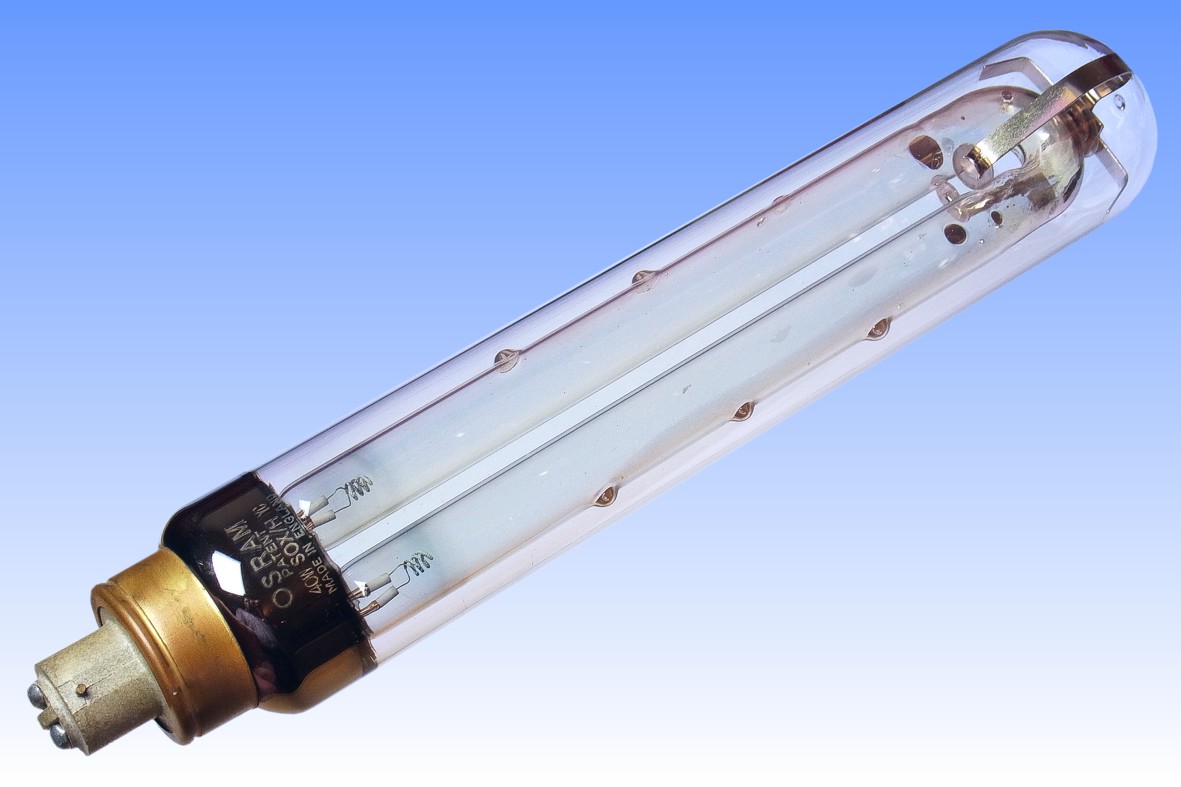
|
GEC SOX/H 40W with Tin Oxide Film |

The coating material is tin oxide and its thickness is approximately 0.32 microns, at which point the trade-offs between infrared reflection and blocking of visible light are optimised for highest lamp efficacy. Infrared reflectivity is about 80%, and transmission of the sodium yellow light is approximately 88%. Lamps having tin oxide coatings can be recognised by the orange-reddish colour reflections from the coated glass surface, which is evident in some photographs.
The tin-oxide coated lamps were introduced under the name "SOX" in ratings of 40, 60, 100 and 150W to replace the former "SOI" types 60, 85, 140 and 200W - offering both an energy saving and simultaneous increase in luminous flux. There was no replacement for the 45W SOI. Osram-GEC was quick to follow suit with the launch of its own range, represented by the lamp on this page. Unusually for that company, the discharge tube feature Philips-style sodium-retaining dimples, which were employed for a few years. The discharge tube bend is suspended between small mica discs held by a tulip-shaped metal spring clip, and a mica disc at the lower end. By 1968 these tin-oxide lamps had been replaced by another Philips development, in which the coating was changed to a superior indium-tin oxide film.



| Manufacturer: | The General Electric Company of England PLC | |
| Lamp Power: | 40 Watts | |
| Lamp Current: | 0.6 Amps | 0.54A Starting Current |
| Lamp Voltage: | 75 Volts | 450V ignition |
| Cap Type: | BY22d | Porcelain Insulator |
| Bulb Type: | T-50 | T-16 in eighths/inch |
| Bulb Finish: | Tin oxide film | Soda-lime glass |
| Electrodes: | CCC-4 Beehive | Black W + BCT emitter |
| Arc Length: | ||
| Atmosphere: | Na | 99% Ne, 1% Ar | Outer: Hard Vacuum |
| Luminous Flux: | 4,300 lm (@ 100 hrs) | 4,085 lm (mean to 4000hrs) |
| Luminous Efficacy: | 107.5 lm/W (@ 100 hrs) | |
| Colour Temperature & CRI: | CCT: 1700K | CRI: Ra -44 |
| Chromaticity Co-ordinates: | CCx: 0.574 | CCy: 0.425 |
| Rated Lifetime: | 6,000 hours | 50% survival |
| Warm-up & Re-strike time: | Approx. 15 minutes | Instantaneous |
| Burning Position: | Vertical cap up ± 110° | |
| Overall Length: | 312 mm | 12¼ inches |
| Light Centre Length: | 190 mm | 7½ inches |
| Factory: | Shaw, Oldham | England |
| Date of Manufacture: | March 1967 | |
| Original / Present Value: | Unknown | |
